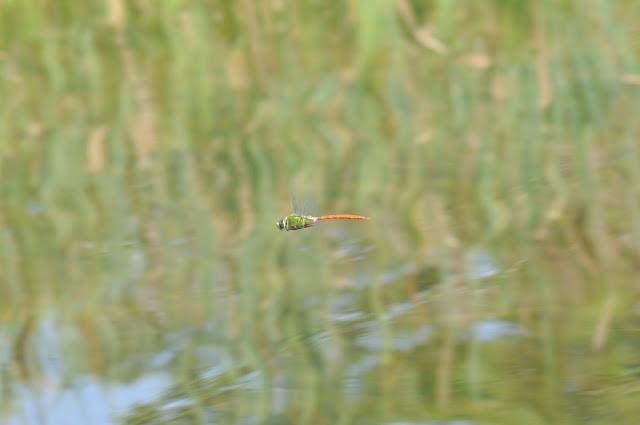Betsy and I went to Smiley's Bottom in downtown Anacortes yesterday. We weren't expecting to see that much, based on the recent low activity level at Cranberry Lake. Instead, we were pleasantly surprised to find a convention of Cardinal Meadowhawks in full swing. Now a group of cardinals who choose the pope is called a college or a conclave, but I think a
convention of cardinals suits our meadowhawk friends. The convention consisted of several male meadowhawks staking out prime territory along the edge of a pond, and a few pairs in tandem dipping in the water to lay eggs.
Cardinal Meadowhawks are incredibly colorful – a treat for the eye. In addition, they have a perching index of about 90%, meaning they spend 90% of their time perched waiting for prey or a mate. This makes them an ideal subject for close observations with binoculars or a spotting scope, and for photographs as well. Just find a favorite perching site of one of the males, position yourself nearby, then wait for him to return and put on a show for you. Here's one from yesterday that landed just inches from me.
 |
| Cardinal Meadowhawk (male). The small yellow dots on the abdomen are a holdover from his days as a teneral, when he was mostly yellow. |
 |
| Notice the concentrations of dark red color near the base of the wings. This is a key field mark for these dragonflies. |
 |
| Young dragonflies like this one have "blank expressions" in their eyes. As the eyes mature they become more transparent and show noticeable pseudopupils. |
Cardinal Meadowhawks are easy to ID. First, they are intensely red. Once you get to see the red of a Cardinal Meadowhawk it's pretty easy to recognize it when you see it again. Second, they have a concentration of dark red color at the wing bases. This feature distinguishes the Cardinal from all other meadowhawks in our area, and is readily visible from almost any angle.
As mentioned above, Cardinal Meadowhawks generally lay eggs in tandem. They hover low over the water, then gently dip down to immerse the tip of the female's abdomen, at which point she releases a few eggs into the water. Here are a couple shots showing the egg laying in action.
 |
| Cardinal Meadowhawks flying in tandem, preparing to lay eggs. |
 |
| The actual process of laying eggs is quite gentle in Cardinal Meadowhawks. Female Autumn Meadowhawks don't have it so easy. |
Other dragonflies at Smiley's Bottom yesterday included a single Four-spotted Skimmer and several California Darners. One of the California Darners was seen to do a spin-dry, something we've seen them do several times so far this year.






















